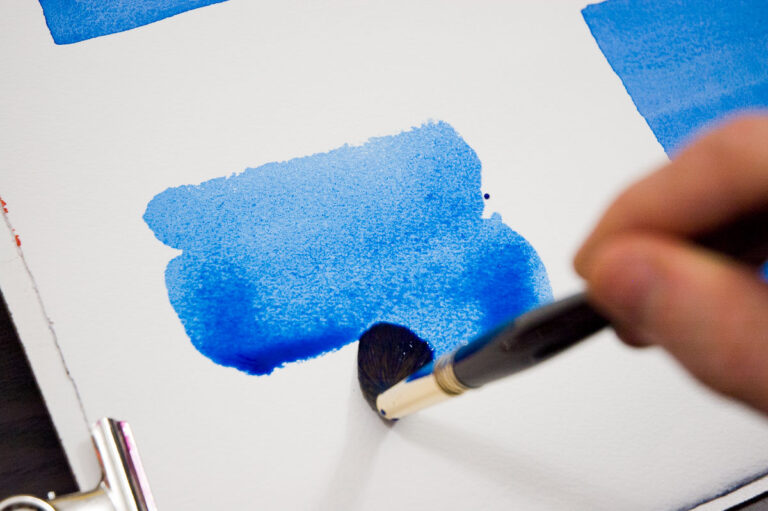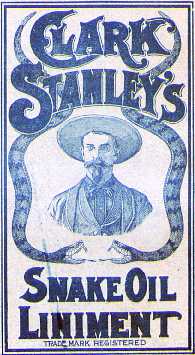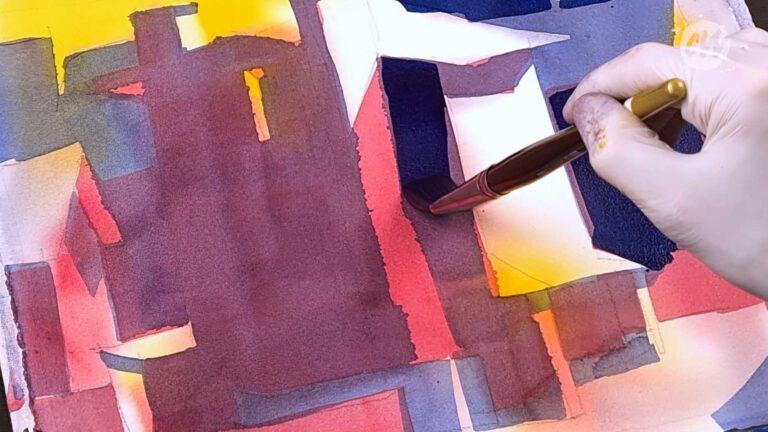

Creativity is an integral part of being human. Scientific advances are a testament to the human capacity to invent. While everyone’s creativity peaks at different levels, it’s a fact that everyone can stimulate its development regardless of age or past experience.
I believe that there are three components to full creative development. I express these through three simple, straightforward verbs:
Learn. Paint. Enjoy.
Understanding the theoretical concepts and underlying principles that rule art-making creates a foundation upon which your entire practice stands.
If you build a house on weak foundation it’s going to crumble, no matter the amount of time, money, sweat and tears you put into building it. That’s why having proper understanding of the concepts of art-making is paramount: all your practice will be for naught unless you truly understand what you’re doing and why. Growth is enabled through understanding. Mastery can only be achieved through practicing with full awareness.

(… or do any of these red flags ring a bell?)
This may seem harsh but I’m simply being honest with you.
I should know. I’ve been through the wringer myself! For the first 10 years of my own practice I studied, struggled, tried and failed and then failed some more! I hardly developed as an artist. I spend a fortune on books, films, courses and materials I didn’t need but hoped would help me get better. Of course, they did little except make me more frustrated. Because while every book or video has the potential to teach you something, very few are meant to teach you anything of real value!
Of course nothing worked! Until something did… What I learned form all this was…
There’s no easy way to say this and it may shock you but you have to:
There are no pretty pictures – there’s simply objectively good and objectively bad art. Painting a “pretty picture” usually means copying someone else’s style without having the proper foundation. Stop looking for formulas. Kimon Nicolaïdes said it best: “You cannot start where some other painter left off. You have to start where he started – at the beginning – and you have to start with the same integrity and the same interest.”
There aren’t any shortcuts to becoming an artist. No instant magic formulas. You can only go through the process yourself. The only shortcut you can get is to learn the right way. Start with the fundamental concepts of art-making, building a strong foundation and maintaining a painting routine that utilizes momentum to get your practice rolling. This way, you’ll soon become your own teacher.
There are no quick & easy fixes in watercolor. If you build a house on a weak foundation it’s going to crumble, regardless of how much time you spent building it. First, understand the creative concepts of painting. Then allow your hand the time and repetition to acquire the necessary skill. After mastering these essentials of watercolor painting your journey can begin. There’s no ‘instant’ in watercolor. It’s all marketing B.S.


Practice makes perfect.
Painting is, in the first place, in the hand. By all means, learn all you can about the mechanics of handling the brush – your practice will be the better for it. But beware: the hand only does the mind’s bidding.
Don’t waste time mimicking the technique of others without understanding why. There are no shortcuts to mastery. Gimmicks cannot be meaningfully integrated into your practice. They only hurt you in the long run. Strive to know: create regular practice around knowledge and understanding and your work will be genuine and rewarding.
You know how the proverb goes: “Give a man a fish and you feed him for a day, teach a man to fish…”
I tell you what nobody’s telling you: I tell you how a painting is really made. Things that make an artist aren’t difficult to understand. But what you do need is the necessary know-how. The catch is that nobody is willing to part with what really makes an artist. Because once you know, you become an artist in your own right, independent and self-sufficient. Who needs that?
I don’t care about status. I don’t play with the cool kids. I don’t guard anyone’s secrets. And I don’t guarantee your success. I give it to you straight: If you want to learn I’ll show you the way. If you want to learn you’ll have to work for it. A true artist is made in the darkness of their studio, all by their lonesome! Understand that and you won’t need to watch another charismatic teacher showing off while getting zero value in return.
Painting should be fun. But you may be focusing on the wrong definition of fun. Without proper foundation you’re destined to fail time and again. Where’s the fun in that? There’s nothing more satisfying and fun than developing as your own independent artist, empowered by knowledge, forged by experience.
In today’s world of instant success and misleading marketing everybody can become the next Picasso overnight. Just buy this kit and those branded paints and don’t forget that signature brush! Don’t be a sucker. Becoming an artist is a process. It’s rewarding and totally worth it but it does take time. You need to practice and you must stick with it. Your success is your responsibility. The sooner you accept it, the sooner you’ll be on your way to becoming your own, independent artist. I can give you the know-how but you must do the work. That’s my deal.
I’ve been told that I’m not a mediocre person. I don’t want to make mediocre art. And I don’t want to teach mediocrity.
I also believe that whatever I release into the world eventually returns back to me. It’s the same with one’s painting practice. Input equals output. What you put in, you get out. And even though it may not be what the majority wants (in fact, I take that as a good sing), those with genuine intentions and true art spirit can find what they’re looking for: a true value.
While my reasons for this belief are nostalgic and idealistic (the worst reasons to do business) I firmly believe it’s worth it in the long run. Art is one of the few pure and noble pursuits an individual can undertake. While it gets perverted by human greed as everything else, I choose a different path: the path of true artistic development.
I’m first to admit that there’s some amount of sentimentality involved in my teaching strategy. Nobody was there for me when I wanted to become an artist. I didn’t have an opportunity to get into an art school. I didn’t have an experienced and authentic teacher. I worked tooth and nail to understand what is art all about and I built myself up from scratch. Though it would’ve saved me a decade of pointless struggle to have the right start!
High ideals are part of my nature. That’s why I hold art as something magnificent. Art is perhaps even capable of transcending humanity. After all, it’s one of the grand inquiries of humanity. Being involved in art means becoming a part of a brotherhood of great people who came before, bonded through the ultimate struggle of the individual – understanding of self and through it the world in which we live. Art gives a human being another dimension, well above the everyday mundane materialistic life.
I wouldn’t blame you if you thought me an idealistic fool. But there are also utterly practical reasons why I go about teaching watercolor the way I do.
For one, I wouldn’t get where I am otherwise. I lived it. I experienced the struggle. I know what doesn’t work. But I learned what does. And that’s what I teach.
Like in any other discipline, there are more and less effective ways towards mastery. I believe that my way is one of the most effective ways to get you there. I give you the tools that will help you establish a healthy practice, so that you start working as an independent artist. In fact, being independent is a requirement for becoming an original, creative artist. After all, what is art if not the expression of individual’s ideas?
Finally, learning the right way from the start generates a great deal of momentum. It doesn’t only compensate for the steep learning curve, it maintains a positive mindset and clear focus. Providing you persevere, you build your practice on foundations many can’t even imagine.
The power of mind affects the subconscious especially when emotion is present.
Having a joyful attitude towards your practice is a must and leads to almost effortless experience. It helps integrate what you learn seamlessly into your practice, transforming knowledge to wisdom through experience. A strong knowledge base is a prerequisite to consistent enjoyment of your practice, for without knowing you’ll fail time and again. Where’s the fun in that?
Building on strong foundation and practicing what matters develops an unstoppable momentum, leading to painting practice that yields results every time.

For all free lessons, tutorials & tips